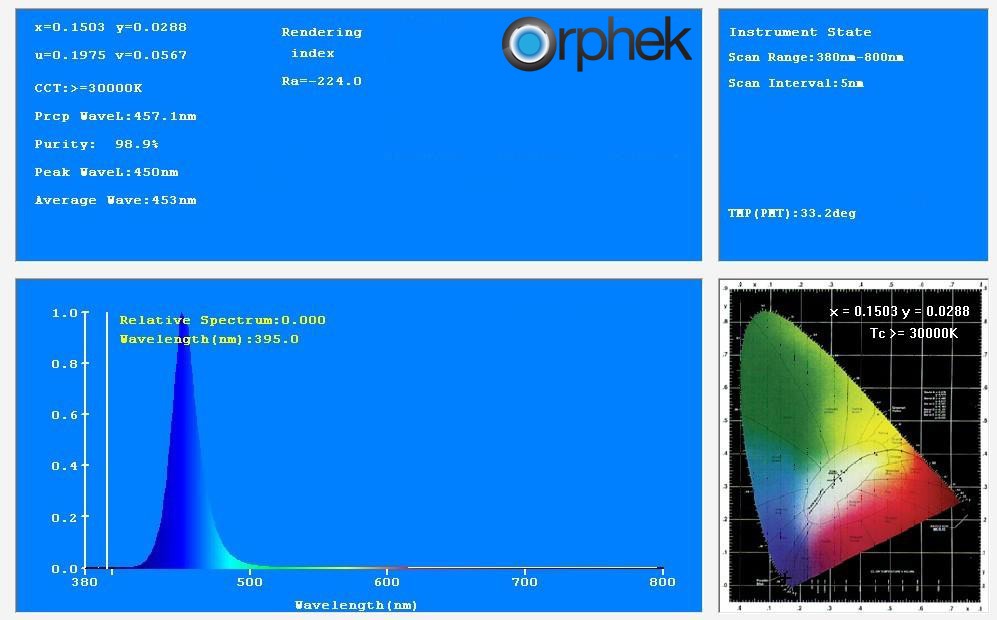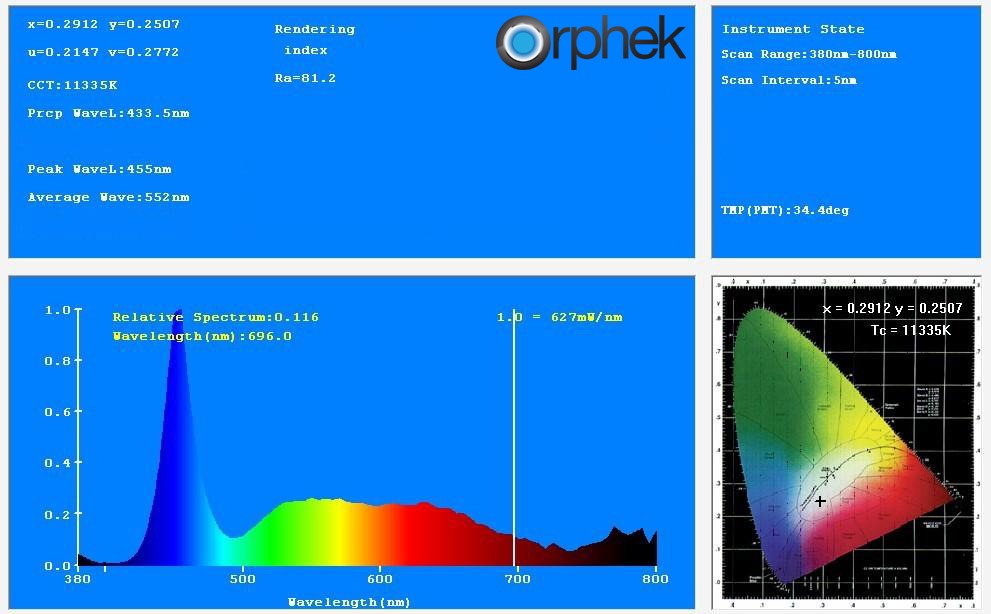


Donate Now
and become
Forum Supporter.

Many perks!
<...more...>


|

10-31-2012, 03:17 AM
|
|
Senior Member
|
|
Join Date: Nov 2007
Zone: 6b
Location: Chester County, PA
Posts: 1,284
|
|
 Aquarium LED fixtures
Aquarium LED fixtures
Many of us reefers and planted tank fans have been following LED's for a number of years waiting for the right time to "pull the trigger" for both their tanks and orchids.
A friend of mine in GWAPA, Greater Washington Aquatic Plant Association posted a link to two beautiful setups I'm considering for my orchidarium. Check out the Atlantik and the Nilus.
Aquarium LED Lighting Reef LED lights | Orphek
Cheers.
Jim
Last edited by DelawareJim; 10-31-2012 at 03:19 AM..
|

10-31-2012, 09:29 AM
|
 |
Senior Member
|
|
Join Date: May 2005
Location: Oak Island NC
Posts: 15,371
|
|
Jim,
Are the wavelengths appropriate?
Seems to me that the attenuation of some of the wavelengths passing through water forces an adjustment of the spectrum to compensate - specifically boosting the blue - and that may not be great for plants. (Most of the aquarium LEDs I've seen are VERY blue).
|

10-31-2012, 10:02 AM
|
|
Senior Member
|
|
Join Date: Nov 2007
Zone: 6b
Location: Chester County, PA
Posts: 1,284
|
|
Ray;
I'm still researching that. You're right that the reef lights run heavy on the blue end and I've seen some LEDs at 40,000'K which I think is crazy. Ideally, I'm looking for something more in the 5500'K - 10,000'K range and they have a 6500'K pendant I'm looking into. Right now I'm running a pair of 175 watt 10,000'K metal halides in an old aquarium fixture hanging in my basement that I've been pretty happy with.
Since they do a bit of customizing with their fixtures, I plan to shoot them an email and inquire what a fixture like what I mentioned above in my desired temp range with a couple of red LEDs would cost.
Cheers.
Jim
|

10-31-2012, 10:53 AM
|
|
Senior Member
|
|
Join Date: Nov 2010
Location: Southern California, Los Angeles
Posts: 965
|
|
Quote:
Originally Posted by DelawareJim

Ray;
I'm still researching that. You're right that the reef lights run heavy on the blue end and I've seen some LEDs at 40,000'K which I think is crazy. ...
Jim
|
All the more evidence that color temperatures, as they are commonly used, and especially for LEDs, are meaningless. Color temperature applies to blackbody radiators not LEDs. A blackbody radiator with a temperature of 40,000degK would have its peak radiation in the far ultraviolet - around 70 nm, an extreme hazard to all forms of life, if it were true, but no LEDs radiate anywhere near 70 nm.
LEDs are not blackbody radiators. Each type of LED radiates in a specific narrow wavelength range. Manufacturers of these fixtures should specify the specific wavelength for each type of LED in the fixture not some bogus, useless "color temperature". |

10-31-2012, 11:28 AM
|
|
Member
|
|
Join Date: Sep 2011
Zone: 8a
Location: Luesia, Aragon, Spain.
Age: 37
Posts: 53
|
|
This topic I talk about something, you can look at the graphics that wavelength does chlorophyll. This is expressed in the unit "nm".
Compare these graphs with providing these LED bulbs.
http://www.orchidboard.com/community...rum-chart.html
With these operating wavelengths chlorophyll.

And these are the wavelengths provided by LED bulbs that you propose.
ORPHEK ATLANTIK




It looks a great deficiency of red, between 600 and 700 nm.
Orphek DIF 100 XP

All models are too few red colored LED bulbs.
This is the configuration of my LED spotlight, especially for growing plants, prioritizing green correct visualization of plants.

This is the one of these aquarium lights.



In short do not think are suitable for the cultivation of land plants, either orchids or any other plant than an algae.
I hope it's for your help.
A hug. |

11-04-2012, 07:57 AM
|
 |
Senior Member
|
|
Join Date: May 2005
Location: Oak Island NC
Posts: 15,371
|
|

Quote:
Originally Posted by DavidCampen

Each type of LED radiates in a specific narrow wavelength range. Manufacturers of these fixtures should specify the specific wavelength for each type of LED in the fixture not some bogus, useless "color temperature".
|
Not true, David.
Of the 64 chips in the LEDs I am carrying, only 8 are discrete wavelength types - the red ones. The other 56 are phosphor-type chips that use a blue or UV LED to excite a phosphor into emitting a wide spectrum of light, not a discrete wavelength. Same principle as a fluorescent tube. There are three different chips on the board, and if they were all discrete, the spectrophotographic plot would show three, discrete peaks.

You are correct about the common use of the corrected color temperature. it is intended to discern differences to the eye, not strictly the definition of the spectrum as color temperature was originally derived. However, in high-quality horticultural light sources (designed specifically for plants), the phosphors are combined to replicate the original more closely.
Last edited by Ray; 11-04-2012 at 08:27 AM..
|

11-04-2012, 01:28 PM
|
|
Senior Member
|
|
Join Date: Nov 2010
Location: Southern California, Los Angeles
Posts: 965
|
|
Quote:
Originally Posted by Ray

... You are correct about the common use of the corrected color temperature. it is intended to discern differences to the eye, not strictly the definition of the spectrum as color temperature was originally derived. However, in high-quality horticultural light sources (designed specifically for plants), the phosphors are combined to replicate the original more closely.
|
To replicate what "original"?
High quality horticultural LED light sources use predominately blue and red LEDs (no phosphor). White LEDs, because of their lesser efficiency, are used only if necessary to assist the humans working with the plants.
Philips GreenPower Horticultural LED Grow Lights |

10-31-2012, 11:10 AM
|
|
Senior Member
|
|
Join Date: Nov 2010
Location: Southern California, Los Angeles
Posts: 965
|
|
|

10-31-2012, 12:56 PM
|
|
Senior Member
|
|
Join Date: Nov 2007
Zone: 6b
Location: Chester County, PA
Posts: 1,284
|
|
Quote:
Originally Posted by DavidCampen

|
David;
Thanks for the link. Looking at the brochure quickly, I didn't see any mention of the wavelengths for these lights. Have you used them?
Thanks.
Cheers.
Jim |

10-31-2012, 01:10 PM
|
|
Senior Member
|
|
Join Date: Nov 2010
Location: Southern California, Los Angeles
Posts: 965
|
|
I haven't used the Philips fixtures. I built my own so that I could utilize one of the principal adavantages of LEDs - that they are nearly a point source of light and thus can be tightly focused.
http://www.orchidboard.com/community...your-home.html
Yes, unfortunate that even Philips neglects to mention the LED wavelengths. There aren't that many LED colors available, all of the manufacturers have the same color set. So when the Philips literature says blue they mean about 460 nm (Cree has some at about 450 nm that they call Royal Blue), deep red will be about 660 nm and far red about 740 nm.
These LEDs are the standard color set:
LED Engin |
|
Currently Active Users Viewing This Thread: 1 (0 members and 1 guests)
|
|
|
 Posting Rules
Posting Rules
|
You may not post new threads
You may not post replies
You may not post attachments
You may not edit your posts
HTML code is Off
|
|
|
All times are GMT -4. The time now is 01:51 AM.
|











































 Hybrid Mode
Hybrid Mode

